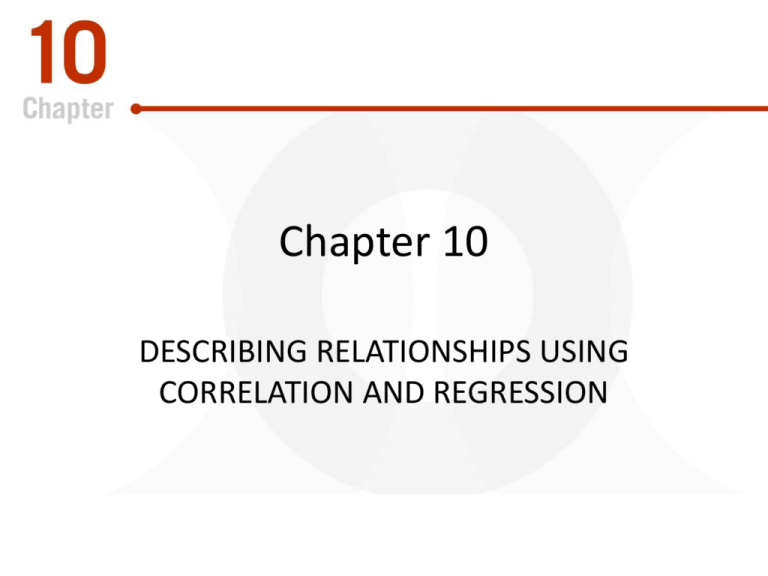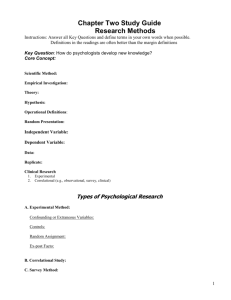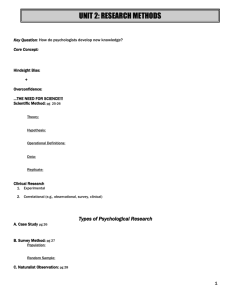Chapter 10 - Bakersfield College
advertisement

Chapter 10 DESCRIBING RELATIONSHIPS USING CORRELATION AND REGRESSION Going Forward Your goals in this chapter are to learn: • How to create and interpret a scatterplot • What a regression line is • When and how to compute the Pearson r • How to perform significance testing of the Pearson r • The logic of predicting scores using linear 2 regression and r Understanding Correlations Correlation Coefficient • A correlation coefficient is a statistic that describes the important characteristics of a relationship • It simplifies a complex relationship involving many scores into one number that is easily interpreted Distinguishing Characteristics • A scatterplot is a graph of the individual data points from a set of X-Y pairs • When a relationship exists, as the X scores increase, the Y scores change such that different values Y tend to be paired with different values of X A Scatterplot Showing the Existence of a Relationship Between the Two Variables Linear Relationships • A linear relationship forms a pattern following one straight line • The linear regression line is the straight line that summarizes a relationship by passing through the center of the scatterplot Positive and Negative Relationships • In a positive linear relationship, as the X scores increase, the Y scores also tend to increase • In a negative linear relationship, as the scores on the X variable increase, the Y scores tend to decrease Scatterplot of a Positive Linear Relationship Scatterplot of a Negative Linear Relationship Nonlinear Relationships In a nonlinear relationship, as the X scores increase, the Y scores do not only increase or only decrease: at some point, the Y scores alter their direction of change. Scatterplot of a Nonlinear Relationship Strength of a Relationship The strength of a relationship is the extent to which one value of Y is consistently paired with one and only one value of X • The larger the absolute value of the correlation coefficient, the stronger the relationship • The sign of the correlation coefficient indicates the direction of a linear relationship Correlation Coefficients • Correlation coefficients may range between –1 and +1. The closer to ±1 the coefficient is, the stronger the relationship; the closer to 0 the coefficient is, the weaker the relationship. • As the variability in the Y scores at each X becomes larger, the relationship becomes weaker Correlation Coefficient A correlation coefficient tells you • The relative degree of consistency with which Ys are paired with Xs • The variability in the group of Y scores paired with each X • How closely the scatterplot fits the regression line • The relative accuracy of prediction A Perfect Correlation (±1) Intermediate Strength Correlation No Relationship The Pearson Correlation Coefficient Pearson Correlation Coefficient Describes the linear relationship between two interval variables, two ratio variables, or one interval and one ratio variable. The computing formula is r N (XY ) (X )(Y ) [ N ( X ) ( X ) ] [ N ( Y ) ( Y ) ] 2 2 2 2 Step-by-Step Step 1. Compute the necessary components: • X • Y 2 2 • ( X ) • (Y ) 2 2 • X • Y • XY • N Step-by-Step • Step 2. Use these values to compute the numerator N (XY ) (X )(Y ) • Step 3. Use these values to compute the denominator and then divide to find r [ N (X ) (X ) ][ N (Y ) (Y ) ] 2 2 2 2 Significance Testing of the Pearson r Two-Tailed Test of the Pearson r • Statistical hypotheses for a two-tailed test H 0 : r 0; H a : r 0 • This H0 indicates the r value we obtained from our sample is because of sampling error • The sampling distribution of r shows all possible values of r that occur when samples are drawn from a population in which r = 0 Two-Tailed Test of the Pearson r Two-Tailed Test of the Pearson r • Find appropriate rcrit from the table based on – Whether you are using a two-tailed or one-tailed test – Your chosen a – The degrees of freedom (df) where df = N – 2, where N is the number of X-Y pairs in the data • If robt is beyond rcrit, reject H0 and accept Ha • Otherwise, fail to reject H0 One-Tailed Test of the Pearson r • One-tailed, predicting positive correlation H 0 : r 0; H a : r 0 • One-tailed, predicting negative correlation H 0 : r 0; H a : r 0 An Introduction to Linear Regression Linear Regression Linear regression is the procedure for predicting unknown Y scores based on known correlated X scores. • X is the predictor variable • Y is the criterion variable • The symbol for the predicted Y score is Y (pronounced Y prime) Linear Regression The equation that produces the value of Y at each X and defines the straight line that summarizes the relationship is called the linear regression equation. Proportion of Variance Accounted For • The proportion of variance accounted for describes the proportion of all differences in Y scores that are associated with changes in the X variable • The proportion of variance accounted for equals r 2 Example 1 For the following data set of interval/ratio scores, calculate the Pearson correlation coefficient. X Y 1 8 2 6 3 6 4 5 5 1 6 3 Example 1 Pearson Correlation Coefficient • Determine N • Calculate X , (X ) , X , Y , (Y ) , 2 Y , and XY 2 2 2 • Insert each value into the following formula r N (XY ) (X )(Y ) [ N ( X ) ( X ) ] [ N ( Y ) ( Y ) ] 2 2 2 2 Example 1 Pearson Correlation Coefficient N=6 X X2 Y Y2 XY 1 1 8 64 8 2 4 6 36 12 3 9 6 36 18 4 16 5 25 20 5 25 1 1 5 6 36 3 9 18 X = 21 X 2 = 91 Y = 29 Y 2 = 171 XY = 81 Example 1 Pearson Correlation Coefficient r N (XY ) (X )(Y ) [ N ( X 2 ) ( X ) 2 ] [ N ( Y 2 ) ( Y ) 2 6(81) (21)( 29) 486 609 2 2 [105][185] [6(91) (21) ][6(171) (29) 123 0.88 139.374 Example 2 Significance Test of the Pearson r Conduct a two-tailed significance test of the Pearson r just calculated. Use a = .05. • df = N – 2 = 6 – 2 = 4 • rcrit = 0.811 • Since robt of –0.88 falls beyond the critical value of –0.811, reject H0 and accept Ha. • The correlation in the population is significantly different from 0 Example 3 Proportion of Variance Accounted For Calculate the proportion of variance accounted for, using the given data. Proportion of variance accounted for is r 0.88 0.7744 2 2




